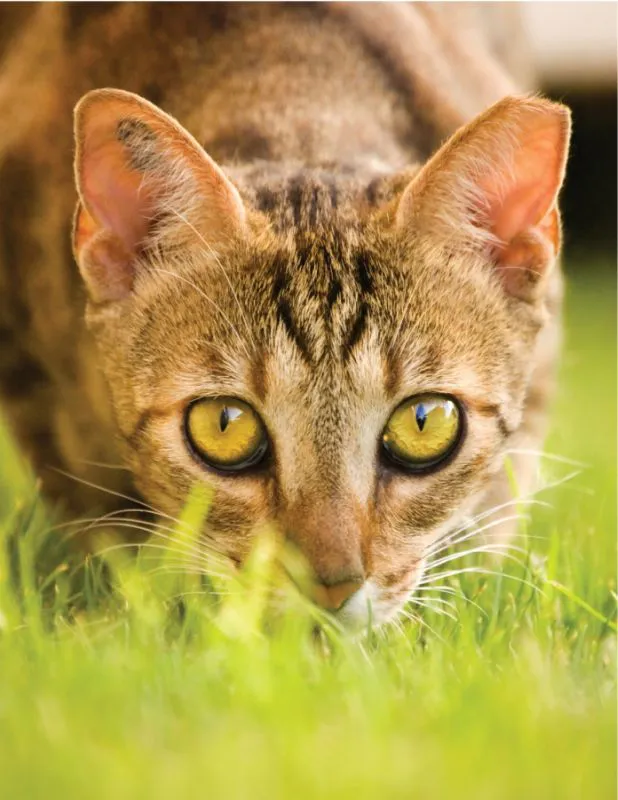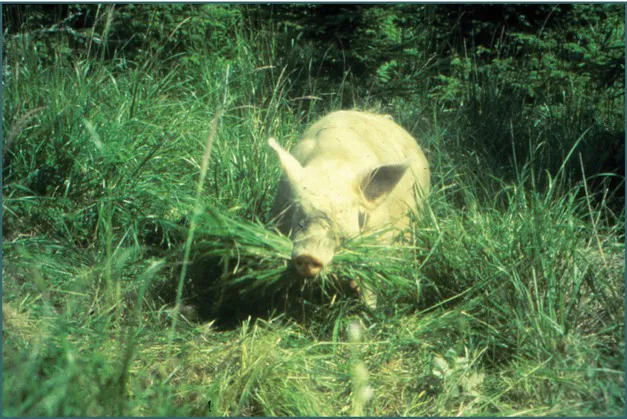![]()
Part A
Basic Elements of Animal Behaviour
Editor’s Introduction
The first nine chapters of this book introduce the basic concepts and the central subject matters required for a firm understanding of the biological bases of animal behaviour. The first chapter provides a historical background, which may help in understanding the questions that occupy contemporary ethology and its applied branches. In the second chapter, we approach the important question of how behaviour is controlled by genes (the nature–nurture problem) and also what this means for behavioural evolution. This chapter also describes the process of domestication, which is essential for understanding present-day domestic animals. The third chapter goes to some depth in describing how observable behaviour is a result of physiological processes throughout the body. The concept of motivation has a long history in ethology, and has proven to be essential for understanding the cognitive capacities and needs of animals in captivity, and the concept receives a detailed treatment in the fourth chapter. This leads naturally on to the fifth chapter, where learning and cognition are in focus. Here, considerable scientific advance has been made over the last decade, and this is introduced to the reader together with its relevance for animal welfare.
In Chapter 6, we move towards a more evolutionary and ecological approach to behaviour. Social and reproductive behaviour are important elements of applied ethology, since animals are normally kept in groups and they are expected to reproduce. The topic of the seventh chapter is play behaviour, a phenomenon well-known to all, but until recently poorly understood by science. In Chapter 8, the reader receives a thorough introduction to the concepts of individual variation and personality, of high relevance for ethology and animal welfare. Chapter 9 moves into the important aspects of abnormal behaviour and stress, and raises some central topics in contemporary applied ethology, such as how the behaviour of an animal can be used to assess its welfare and whether it is under stress. Furthermore, the relatively novel insights into positive emotions and welfare are covered. In the tenth and last chapter of this section, focus shifts to social interactions with the perhaps most important counterpart of domesticated animals – the human. Extensive research has produced some exciting new aspects on this relationship, and the chapter provides a broad and up-to-date introduction to this.
![]()
1 The Study of Animal Behaviour and Its Applications
P. Jensen
1.1 Introduction
Most people have a clear conception of the meaning of the word ‘behaviour’, yet it is strikingly difficult to define it in a precise way. Since ethology is the science of animal behaviour, its causation and function, it is worthwhile to start with some consideration of what type of biological phenomena may be included in the concept. In its simplest form, behaviour may be series of muscle contractions, perhaps performed in clear response to a specific stimulus, such as in the case of a reflex. However, at the other extreme end we find immensely complex activities, such as birds migrating across the world, continuously assessing their direction and position with the help of various cues from stars, landmarks and geomagneticism. It may not be obvious which stimuli actually trigger the onset of this behaviour. Indeed, a bird kept in a cage in a windowless room with constant light will show strong attempts to escape and move towards south at the right timing, without any relevant external cues at all.
We would use the word behaviour for both these extremes and for many other activities in between in complexity. It will include all types of activities that animals engage in, such as locomotion, grooming, reproduction, caring for young, communication, etc. Behaviour may involve one individual reacting to a stimulus or a physiological change, but may also involve two individuals, each responding to the activities of the other. And why stop there? We would also call it behaviour when animals in a herd or an aggregation coordinate their activities or compete for resources with one another. No wonder ethology is such a complex science, when the phenomena we study are so disparate.
But how did it all begin and how has ethology developed into the science it is today? This chapter will provide a brief overview of some landmarks in history and of the various fields into which the science has branched over the last decades. The field that will interest us most in this book is of course the application of ethology to the study of animals utilized by man.
1.2 The History of Animal Behaviour Studies
No doubt, knowledge of animal behaviour must have been critical for the survival of early Homo sapiens. How could you construct a trap, or kill dangerous prey weighing several times your own weight, unless you have a genuine feeling for animal behaviour? So it should not be any surprise that the earliest ‘documents’ available from humans – cave paintings up to 30,000 years old – are dominated by pictures of animals in various situations. Aristotle published written, systematic observations and ideas about animal behaviour more than 300 years bc (Thorpe, 1979).
One of the first to write about animal behaviour in a modern fashion was the British zoologist John Ray. He published in 1676 a scientific text on the study of ‘instinctive behaviour’ in birds. He was astonished by the fact that birds, removed from their nests as young, would still build species-typical nests when adult. Ray was unable to explain the phenomenon, but noted the fact that very complex behaviour could develop without learning or practice. Almost 100 years later, French naturalists had an important influence on the development of the science. For example, Charles Georges Leroy, who was not a formally trained zoologist, published a book on intelligence and adaptation in animals. Leroy heavily criticized those philosophers who spent their time in their chambers, thinking about the world, rather than observing animals in their natural environments. Only then, he argued, would it be possible to fully appreciate the adaptive capacity and flexibility in the behaviour of animals (Thorpe, 1979). Figure 1.1 illustrates the typical nest-building behaviour of a sow.
Another 100 years on, two important scientists deserve to be mentioned. The first is the British biologist Douglas Spalding, who published a series of papers on the relationship between instinct and experience. Spalding was way ahead of his time in experimental approaches. For example, he hatched eggs from hens by using the heat from a steaming kettle, in order to examine the development of the visual and acoustic senses without the influences of a mother hen (Thorpe, 1979). The second important scientist is no one less than Charles Darwin.
Darwin is probably the person who has had the most significant influence on the development of modern ethology – in fact on all modern biology. Most people know him as the father of the theory of evolution, which in itself, of course, is the foundation for any study of animal behaviour. However, he also approached the subject more directly, and his last published work in 1872, The Expression of the Emotions in Man and Animals, was probably the first modern work on comparative ethology.
1.3 The Schools of the 20th Century
In the beginning of the 20th century, behavioural research grew fast. However, the development in the USA and Europe took different directions. American researchers were influenced by the behaviouristic approach, developed by people such as John B. Watson and later Burrhus Frederic Skinner. Their work was focused primarily on controlled experiments in laboratory environments and their subject species par préférence were rats and mice. At the centre of their interest were the mechanisms of learning and acquisition of behaviour through reinforcement or punishment (Goodenough et al., 1993). The behaviouristic research was concerned with finding general rules and principles of learning, and there was a strong belief that such rules were independent of context. Therefore, the evolutionary histories of the study subjects, or their ecological ways of life, were regarded as irrelevant for the research.
In contrast, in Europe the development of the science was dominated by naturalistic biologists, who spent most of their time observing wild animals in nature. Birds and insects were favourite subjects, and these researchers were mostly interested in instinctive, innate and adaptive behaviour. One of the pioneers was Oskar Heinroth, who first started to use the term ‘ethology’ with the meaning we give it today (Thorpe, 1979). The naturalistic behavioural biologists shared an important approach with the behaviourists. They were not particularly interested in mental processes or emotions that may be associated with behaviour. Such processes were often regarded as unavailable for scientific research, since they were not considered to be observable. Only much later has a scientific interest in mental processes emerged, something that will be dealt with more in later chapters in this book.
In the footsteps of Heinroth, we meet two scientists whose influence over modern ethology cannot be overemphasized: Niko Tinbergen in Holland and Britain, and Konrad Lorenz in Austria. Tinbergen developed a field methodology of high exactness. He designed experiments in which details of the environments of free-living animals were altered and their behaviour could be recorded. He was a true pioneer in experimental ethology (Dawkins et al., 1991). Lorenz, on the other hand, did not go much into nature, but rather bred his experimental animals himself and kept many of them almost as pets. He rarely conducted elaborate experiments and was not prone to quantitative recordings. The strength of Lorenz was on the theoretical level. He formulated many of the fundamental ideas in ethology, and developed the first coherent theory of instinct and innate behaviour (Goodenough et al., 1993).
Lorenz and Tinbergen definitely placed ethology on the solid ground of well-accepted sciences when they, together with the German researcher Karl von Frisch, were awarded the 1973 Nobel Prize in medicine and physiology.
1.4 Modern Approaches to Ethology
From the 1960s onwards, ethology developed into the science it is today. This was guided to a large extent by the research programme formulated by Tinbergen, which is still generally accepted as the fundamentals of ethology (Tinbergen, 1963; Dawkins et al., 1991). This programme is frequently referred to as ‘Tinbergen’s four questions’ and the four aspects of behaviour that he used to define the field of ethology were:
1. What is the causation of the behaviour? The answer to this question refers to the immediate causes, such as which stimuli elicit or stimulate certain behaviour, or which physiological variables, such as hormones, are important in the causation.
2. What is the function of the behaviour? In this case, the answer describes how the behaviour adds to the reproductive success, the fitness, of the animal. It therefore has to do with evolutionary aspects and consequences.
3. How does the behaviour develop during ontogeny? Studies on this question aim at describing the way behaviour is modified by individual experiences.
4. How does the behaviour develop during phylogeny? This is a clearly evolutionary question, and usually calls for comparative studies of related species.
Whereas early ethology was occupied mainly with causation, ontogeny and phylogeny, the research during the 1960s and onwards became increasingly focused on the functional question. Researchers have outlined new theories on how behaviour evolves through individual selection at the gene level, and have provided formal mathematical models for how the functional aspects of behaviour could be determined. The impact of this approach on contemporary animal behaviour science has been tremendous.
One aspect that was not covered by Tinbergen’s questions is what animals perceive, feel and know in relation to their own behaviour. As mentioned earlier, this aspect of animal behaviour was largely considered to be inaccessible to science. However, other scientists have developed methods and concepts to allow investigation into this area. This has led to a new branch of the science, emerging in the 1970s, known as cognitive ethology (Bekoff, 2000) (the word cognition means subjective, mental processes – or thinking).
1.5 Applied Ethology
Even early in the development...


